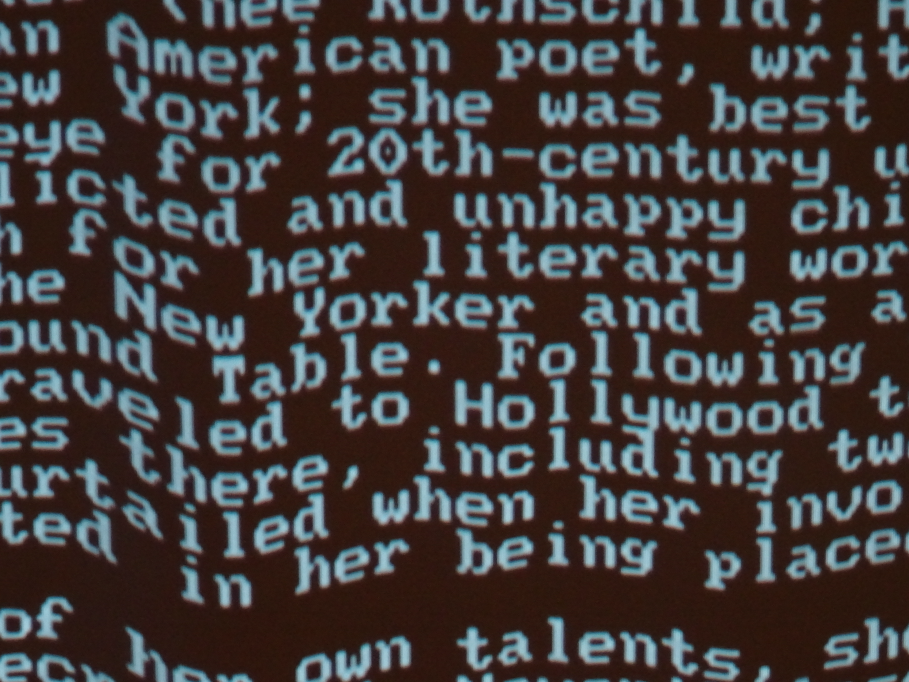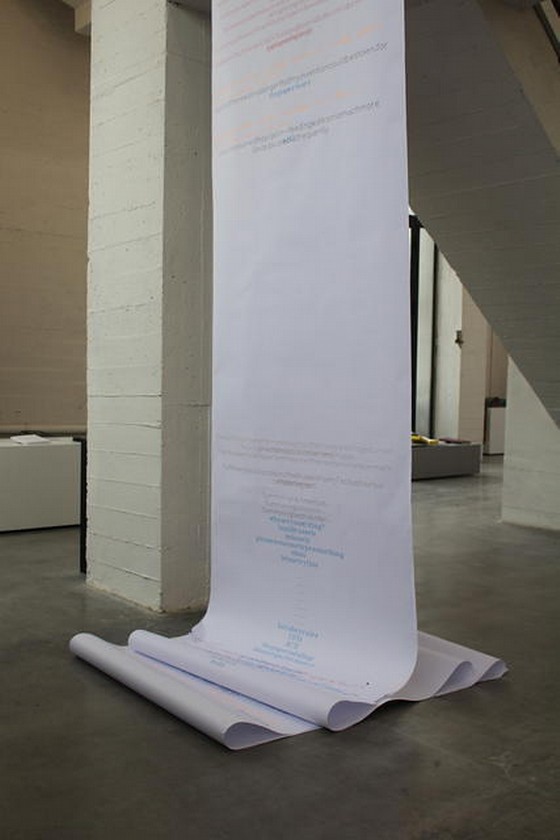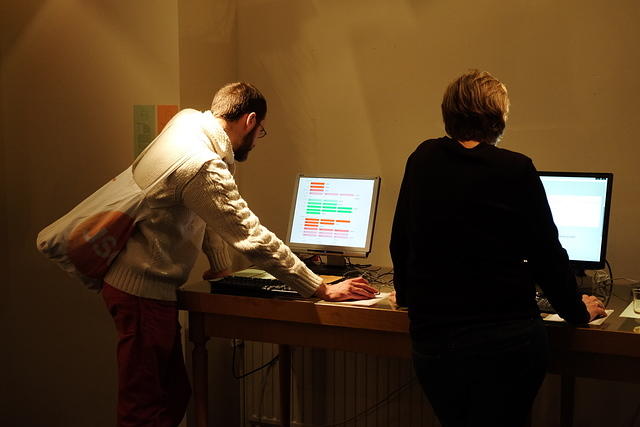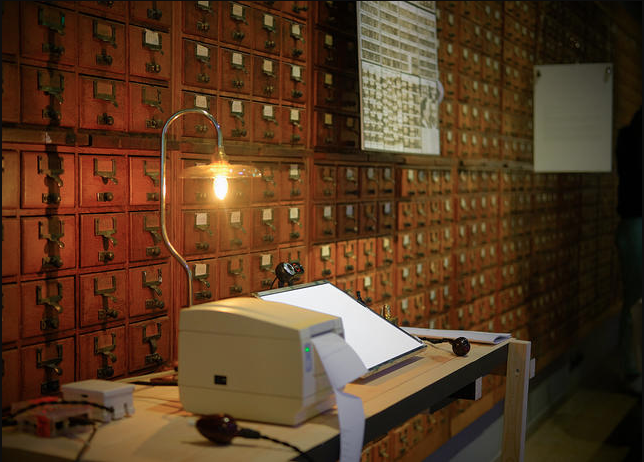Machines as Literary Companions
An Mertens
July 2022
A long-running thread through the manifold work of Constant is an interest in collaborating with machines on installations, worksessions, and publications. Machines as literary companions give a particular form and content to the experience of reading, writing, and rewriting. This essay brings together a few activities from the Constant galaxy to show how their specific choice of Free/Libre Open Source Software (F/LOSS) tools, F/LOSS licenses, and collective practices make these experiments relate in different ways to what has been described as e-literature.

“Growing a Tree” for Data Workers at Mundaneum Mons, organized by Algolit (Gijs de Heij, An Mertens), 2019. CC4r Constant.
Proprietary vs. F/LOSS
Readers with only a slight familiarity with the field [of electronic literature] . . . will probably identify it first with hypertext fiction characterized by linking structures, such as Michael Joyce’s afternoon: a story,1 Stuart Moulthrop’s Victory Garden,2 and Shelley Jackson’s Patchwork Girl.3 These works are written in Storyspace, the hypertext authoring program first created by Michael Joyce, Jay David Bolter, and John B. Smith and then licensed to Mark Bernstein of Eastgate Systems, who has improved, extended, and maintained it. So important was this software, especially to the early development of the field, that works created in it have come to be known as the Storyspace school. . . . Along with Macintosh’s Hypercard, it was the program of choice for many major writers of electronic literature in the late 1980s and 1990s.4
— N. Katherine Hayles, “Electronic Literature: What is it?”
At the beginning of March 2007, a few months after the essay quoted above was written, in the center of Brussels, people walked in and out of the international bookshop Passa Porta. Some were regular customers, others were visitors to the Brussels BRAVO Festival, following a route of art installations in the city. They walked through the bookshop, ignoring the piles of books on tables and shelves that tried to attract their attention, to a staircase leading to a basement room. There they found Transcommunautaire Karaoke Transcommunautaire, an installation by Constant.5
Downstairs, a computer screen displayed text. Each word was spoken by a different voice. The text was sometimes French, sometimes Dutch, alternating between an excerpt from Suzanne Lilar’s French-language novel Une enfance gantoise (1976) and Paul van Ostaijen’s poem “Belgian Sunday” (1928). Another computer invited visitors to read isolated words from both texts. It was not always clear which language it referred to. Sometimes there was confusion. Some words and numbers belonged to multiple languages and were pronounced in the mother tongue of the visitor behind the microphone. The computer recorded without judgment. The official bilingualism of Brussels and its informal multilingualism resonated in this installation thanks to the mediation of the computer – for whom the meaning of a word or how it is pronounced is inaccessible.
I had only recently joined Constant in 2007 and Transcommunautaire Karaoke Transcommunautaire was the first installation in which I saw how machines could not only be used as tools – for things like word processing and video conferences – but that they can also act as literary companions and produce an aesthetic experience. In the small recording studio that was part of the installation, one collaborator explained how the system worked so that visitors could start playing with the machine, which reads, writes, and performs. Each activity showed a different layer of the complex theme of multilingualism in Brussels. The current dominance of the French language was reflected in the text by Susan Lilar, who testifies to the same dominance during the first half of the twentieth century. It highlighted the confusions of speech that are common in Brussels and part of its cultural identity. Here, I clearly felt a sparkle. Constant works with e-lit practices, yet it does so “with an attitude.”6 Is this literature? Clearly. Is this digital literature? Certainly. Is this a collective process? Undoubtedly. Is it exciting to understand how the system works? Sure. Does this show the narrative potential of machines? Oh yes.
In 2008, Hayles published the book Electronic Literature: New Horizons for the Literary, in which she gives a theoretical framework for the first Electronic Literature Collection (co-edited with Nick Montfort, Scott Rettberg, and Stephanie Strickland). It is an important body of work that initiated a canon of electronic literature and helps promote its teaching. But what caught my attention was the following note:
The Collection features sixty recent and new works of electronic literature, all offered under a Creative Commons license (Attribution-NonCommercialNoDerivs 2.5) that allows the works to be freely shared, distributed, and transmitted as long as they are attributed, not used for commercial purposes, or altered.7
Read-Write-Execute (R-W-X)
On January 1, 2012, Constant celebrated the Public Domain Day for the first time. Every year on New Year’s Day, due to the expiration of copyright protection terms on works produced by authors who died seventy years earlier, thousands of works enter the public domain – that is, their content is no longer owned or controlled by anyone. It becomes a common treasure, freely available for anyone to use for any purpose. That year, copyright expired on the oeuvre of famous authors like Virginia Woolf, James Joyce, Rabindranath Tagore, Elizabeth von Arnim, Sherwood Anderson, and Henri Bergson. This meant the texts could be re-used in new works of art; they could be changed and re-published. It inspired my colleague Femke Snelting and I to create a new work based on the works of these celebrated authors, which we called The Death of the Authors, 1941.
The Death of the Authors, 1941 is a generative novel made with Python and NLTK (Natural Language Toolkit), based on texts by the authors mentioned above. Every time you launch the script, a different novel is created. As an homage to the life and demise of authors whose bodies merged with earth in 1941, each version takes you through four seasons composed of thematically selected sentences from their liberated texts. Every generated version allows for a sensorial reading in which the chapters collect sentences from two different novels with words that relate to different sensations. Spring, for example, is linked to words such as birth, butterfly, flower, energy, breakthrough, sprawl, toddler, and grow; whereas winter focuses on words like death, ice, cold, illness, ruin, decay, medicine, pus, infection, and virus. For readers who know the oeuvres of the authors, reading becomes an exciting game to recognize the sentences. For others, it allows for a sensorial reading based on impressions and experiences linked to the four seasons. Thus, The Death of the Authors series was born.

“The Death of the Authors, 1943 (a botopera)” by Michael Murtaugh, Anne Laforet, Gijs De Heij, Antonio Roberts, and An Mertens. CC4r Constant.
Later that year, together with Constant member Nicolas Malevé, I met the artists and members of PiNG (Catherine Lenoble and Olivier Heinry), an association focused on digital practices based in Nantes since 2004. The four of us were interested in F/LOSS literature and working with a read-write-execute attitude – in other words, the freedoms that are embedded in code and works published under an open content license, like the GNU General Public License, where any user can look at the code or work (read), change it (write) and redistribute it (execute) – and that this approach to artworks remains absent in the collection created by the Electronic Literature Foundation. In the paper “Review: The Electronic Literature Collection Volume I: A New Media Primer,” Mark C. Marino wrote:
The No-Derivative Works restriction prevents corporations from taking this content and developing a viral marketing version of, say, “Lexia to Perplexia.” However, the restriction also prohibits a new net artist from transferring their own deck of words into, for example, “Stud Poetry,” a piece which rewires a poker game to generate poetry. Nonetheless, a user could request permission for derivative works, which is just the kind of community-building the Electronic Literature Organization tries to foster.8
Yet, we had many questions: How is it possible that university professors do not see the revolutionary potential of literature that is generated by code, which naturally invites the text to be copied, altered, and redistributed? Why do they choose not to publish the source code? Why do they go with the closed format of works, which limits reading to a form of consumption? What if one could show the process of the machine at work? What if a digital narrative work were to take on collective authorship, issued by all the participants who intervened in the creative process?
We decided to meet for four days in Brussels to look at machines as literary companions in a specifically F/LOSS environment. Through this process we created the word i-literature (as opposed to e-literature) to allow for insight, intimacy, and interaction. Thus, Algolit was born – an agenda, a mailing list, and a name for a new artistic research group that would explore practices of free texts and code.
Whereas the notion of literature was quite clear to all four of us, the concept of “algo,” referring to algorithms, turns out to be much more obscure. Nicolas proposed that we take a close look at the Quicksort algorithm and physically execute it.9 Later, this exercise was transformed using L’Abécédaire, one of the constraints used by Oulipo that conditions all the words of a sentence or verse to appear in alphabetical order. Oulipo stands for Ouvroir de Littérature Potentielle (Workplace for Potential Literature), a collective of poets and mathematicians initiated in the 1960s in Paris by the authors Raymond Queneau and François Le Lionnais. The Quicksort exercise allows this ordering. This interest in a narrative perspective of the algorithm became an essential drive in Algolit’s practices.
With the fresh wind of Algolit in our backs, we presented The Death of the Authors, 1941 on Public Domain Day in March 2013. Femke made a new version of the book called The Couplets and presented it in November 2013 at Het Nieuwe Instituut in Rotterdam. Later, we decided to generate three different novels and publish them in print form, sold as a set by Books with an Attitude.10
Collective Practices
Tools shape practice; practice shapes tools.
This was the adage of the Libre Graphics Meeting at Medialab-Prado, Madrid in 2013, organized by Constant’s Libre Graphics Research Unit. Stickers were distributed that carried this slogan. It is remarkable how an object carrying a message can resonate in different dimensions of time and space. When the question But what about machine learning? was raised during an Algolit session, this slogan popped up again in response.
We took the question But what about machine learning? into account for the organization of the Constant worksession Cqrrelations in Brussels in January 2015. During the second week we explored the machine-learning library Pattern for Python developed by the CLiPS (Computational Linguistics, Psycholinguistics and Sociolinguistics) research center at the University of Antwerp. This library allows for data mining, natural language processing, machine learning, and visualizations. We looked closely at the tool to explore its poetic possibilities.
Spending a week in one room with around twenty people who are looking at the same tool is a very rich experience. You come to understand that no one uses code in the same way, that no one sees the potentials and pitfalls of a coding tool in the same way, and that no one opts for the same use of the tool. The combination of experimenting with poetic creation and formulating critiques of the extraction and optimization policies of this tool became the main challenge in the room. The multidimensionality of approaches that naturally comes into being while sharing coffee, meals, and cigarette breaks generated insights, collaborations, and a collection of experiments. In the multiple ways of unpacking and hacking the tool, something that looks like the narrative point of view of the algorithm emerged – a form of writing under constraint, a visibility of the performing software that usually remains hidden. The software is not optimally executing anymore, but it poetically shows how it calculates what data is being used to learn patterns. And in doing so, it brings new stories into the world. At the end of the worksession, the experiments were presented as part of a panel discussion at the CPDP (Computers, Privacy, and Data Protection) Conference 2015.
After this worksession, Algolit continued adopting the same methodology focusing on one tool at a time. Quite quickly we developed a procedure for “algoliterary experiments”: we try to find the tool, read about it, and understand it by going through the code, executing and commenting line after line. Next, we apply the tool to a familiar corpus. In the end, what we get is a poetic form as a result of using the tool itself, and a metaphorically fitting text.
Two years later, Algolit presented the results of this experimentation in the exhibition Algoliterary Encounters (November 2017). The strength of this collective effort was demonstrated by algoliterary works using machine-learning tools that try to open up the black boxes of their code in different ways. Every installation highlighted a different aspect of a machine-learning tool. Some focused on the reduction of language in models like word2vec; some showed the importance of the quality of the dataset for the machine to learn, while others showed the learning process of the machine in different steps. In other words, the exhibition was like an anthology of i-literature that used machine-learning.

Algoliterary Encounters by Algolit, 2017. La Maison du Livre, Brussels. CC4r Constant.
Showing the Process
Programming languages have supplemented natural languages, suggesting the need for new literacies that include both natural and artificial languages. These languages form a “postmodern tower of Babel,” as he [Kittler] puts it, and this is why: “We simply do not know what our writing does.” Kittler is partly referring to the ways that graphical interfaces dispense with the need for writing and hide the “machine” from its users.11
— Geoff Cox, Speaking Code
A machine-learning model is a file that has been trained to recognize certain types of patterns in specific data. You train a model based on a dataset, providing it with an algorithm that it can use to analyze and learn from the data. Once you have trained the model, you can use it to analyze data it hasn’t seen before and make predictions about that data. When working with machine-learning tools, it can be fairly easy to use one line of code to train a model. This one line of code refers to another library where all the different steps in the process of learning are written out. The practice of using one line of code is called “off-the-shelf” coding, and it is what most people do.
For people interested in working with the machine as a literary companion, like us, curiosity about the narrative perspective of the algorithm takes over from the one-liner; opening that black box allows for new perspectives. The process of opening up can be compared to the peeling of an onion, where each layer comprises other layers until you arrive at the core. In this case, that means arriving at pure mathematics. Practitioners of i-literature can be intimidated by this unfolding. During Algolit meetings, we make sure that people can stop the peeling process at any time and that stopping is as rewarding as continuing.
As a follow-up to the Algoliterary Encounters exhibition we decided to organize a larger exhibition to show different phases in a machine-learning process. The exhibition was called Data Workers and took place at the Mundaneum in Mons in March 2019. The algoliterary works were organized in different zones referring to the trained models in the different phases of the machine’s learning process: writers, cleaners, informants, readers, learners, and oracles.12

Algorithmic readings of Alphonse Bertillon’s portrait parlé by Algolit (Guillaume Slizewicz) for Data Workers at Mundaneum, 2019. CC4r Constant.
The exhibition was only possible thanks to the collective learning and experimenting that took place during the Algolit sessions. Again, the exhibition could be read as iterations of themes inside each zone, showing different approaches around similar materials. As with all activities in which machines collaborate as literary companions, the code of the exhibition is published online under an open content license, ready to be re-read, re-written, re-executed. This potential for endless iterations that is part of the F/LOSS culture invites entangled, incremental, and interdependent art histories that are never definitive or final. Instead, they continuously generate tales and stories.13
Collection with an Attitude
A lot of the works and experiments I describe are textual interfaces rather than animated platforms with sound, images, or video.14 They come closer to Dadaist poetry than to video games. This aesthetic emerges from the F/LOSS tools that are used. It is reminiscent of the command line where you can “see” or “read” things happen as lines of text. In this sense, one could speak about a read-write-execute style.
In the meantime, the fourth volume of the Electronic Literature Collection has been published. It is yet another precious body of work. Some artists present in the volume share an aesthetic and attitude that are close to what I have described here – like Alisson Parrish, who also published the code in the collection, or Liza Daly, who has published the source code on her website.
Working with machines as literary companions in the network of Constant also includes studying the machine, the dataset, and the process. This means that the literary quality of these works is dependent on how much the machine is taken seriously as a literary companion. In other words, the circumstances are created for this companion to narrate “its” point of view in the most critical way possible, rather than using the tool to create digital stories. The creation of spaces for exchange, collective experimenting, and sharing – in, for example, Constant’s worksessions or the Algolit meetings – allows for a kind of versioning effect in the resulting works.
When looking at the combination of all these elements, it might be the right moment to start organizing these i-literature works into a collection with an attitude (following the example of Books with an Attitude, as recently described by Mia Melvær). As with all of Constant’s projects, the i-literature collection would be an “active archive” that comes with invitations for moments of collective creation and activation, the results of which could endlessly be added to and change the collection. This is what machines as literary companions invite us to do: to execute, distribute, adapt, and redistribute their ever-changing combination of bits and bites.
With a big thank you to all who contributed to Algolit, temporarily or long-term, from far away or close by.
Copyleft 2022 An Mertens. You may copy, distribute, and modify this material according to the terms of the Collective Conditions for Re-Use (CC4r) 1.0.
Footnotes
- Michael Joyce, afternoon: a story (Watertown, MA: Eastgate Systems, 1990). An earlier version was circulated in 1987; see Matthew G. Kirschenbaum, “Save As: Michael Joyce’s afternoons,” in Mechanisms: New Media and Forensic Imagination (Cambridge, MA: MIT Press, 2007) for a detailed account of all the different versions and editions.
- Stuart Moulthrop, Victory Garden (Watertown, MA: Eastgate Systems, 1995).
- Shelley Jackson, Patchwork Girl (Watertown, MA: Eastgate Systems, 1995).
- N. Katherine Hayles, “Electronic Literature: What is it?,” The Electronic Literature Organization, January 2, 2007.
- Michael Murtaugh made a virtual remake of the installation available online. Also see pictures and code.
- Books with an Attitude are published by Constant, made with 100% Free and Open Source Software, and released under open content licenses.
- N. Katherine Hayles, Electronic Literature: New Horizons for the Literary (Notre Dame, IN: University of Notre Dame Press, 2008), xi.
- Mark C. Marino, “Review: The Electronic Literature Collection Volume I: A New Media Primer,” Digital Humanities Quarterly 2, no. 1 (2008).
- “Quicksort is an in-place sorting algorithm. Developed by British computer scientist Tony Hoare in 1959 and published in 1961, it is still a commonly used algorithm for sorting.” For further information see: https://en.wikipedia.org/wiki/Quicksort.
- Additionally, in Fall of 2013, the project was selected to be part of the virtual gallery of the exhibition Chercher le Texte, organized in the framework of the Electronic Literature Organization conference in Paris. Alessandro Ludovico later included it in the exhibition Print Error/Publishing in the Digital Age (2012–2014) in the virtual gallery of Jeu de Paume Paris.
- Geoff Cox, Speaking Code: Coding as Aesthetic and Political Expression (Cambridge, MA: MIT Press, 2012), 36.
- The exhibition catalog, beautifully designed by Manetta Berends, can be found here: https://www.algolit.net/index.php?title=File:Data-workers.en.publication.pdf.
- The project Iterations, coordinated by Constant, invited artists to explore this concept.
- This article only references a few of Constant’s machinic activities. If you want to browse more, you can consult wefts here, here, here and here.
An Mertens is a media artist, nature guide, and writer who creates publications, installations, and performances. She was active as a core member of Constant from 2008 to 2021. Her artistic practice focuses on experimental research into creative writing using code. In this context, she founded Algolit in 2012, a transdisciplinary art research group that meets monthly in Brussels. In 2019, she launched the pseudonym Anaïs Berck. This name refers to a collaboration between humans, algorithms, and trees. As a collective, it opens up a space in which human intelligence is put on the same level as plant intelligence and artificial intelligence. The results are Dadaist and instructive poetic experiences.